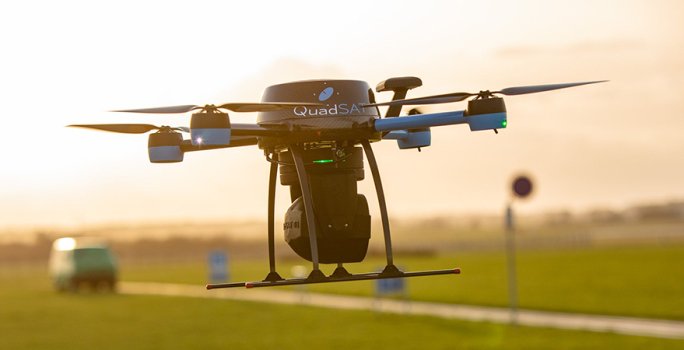K
Kathleen Martin
Guest
Advances in commercial drone technology are opening up new growth opportunities for the space industry, which has an often underappreciated synergistic relationship with uncrewed aerial vehicles.
The fast-evolving market for drones attracted $1.4 billion in venture capital investment in 2020, according to data from early-stage space technology investor Seraphim Capital.
That’s roughly double the amount of capital it recorded in 2019, a sign startups looking to provide services ranging from drone deliveries to building inspections are gaining traction.
Clearing regulatory hurdles so drones can fly autonomously beyond visual line of sight (VLOS), where they can then carry out tasks without human intervention, marks the next step in the market’s evolution — and satellite communications are crucial for making this a reality.
“This has to come from space because you need something that has coverage everywhere, no matter what,” says Joakim Espeland, CEO of Danish drone startup QuadSAT.
While satellites might not be the primary connectivity source for all these next-generation drones, they can provide a layer of resiliency in case 5G wireless or other terrestrial networks fail midflight.
“A drone does all the processing for flying onboard,” Espeland says.
“So the only thing you need is a little bit of data going through, and that can be enough for you to sit on another side of the world and know where the drone is, what speed it’s going at and what orientation it has [and for sending a command] to safely get it back to where it needs to be.
“[A]s drones get full autonomy, we will see that in combination with space technology.”
QuadSAT is returning the favor to the space industry with a business that uses quadcopter drones that act as stand-ins for satellites, enabling operators to test and calibrate their antennas more efficiently than in a laboratory.
Espeland said this capability is becoming increasingly valuable as the rise of megaconstellations places new demands on user terminal development.
U.S.-based startup Rammaxx is also developing a drone-based business that aims to serve the space industry directly.
It recently launched a simplified “electric firework” drone for retail customers, based on those used for large-scale light show displays.
After seeing how its drones could replicate fireworks that shoot quickly and vertically into the sky, Rammaxx CEO Dan Lubrich said it began in December exploring ways to also launch satellites with them.
“As we realized how incredibly quickly drones can go up we realized that it could be useful for vertical lift, especially for space,” Lubrich said.
Rammaxx recently tested a proof of concept where a small group of drones successfully lifted a small-scale rocket to a certain height before detaching from it, enabling the launch vehicle to continue its journey.
Continue reading: https://spacenews.com/connecting-the-dots-drones-in-space-satellites-seen-as-key-to-giving-full-autonomy-to-uncrewed-aerial-vehicles/
The fast-evolving market for drones attracted $1.4 billion in venture capital investment in 2020, according to data from early-stage space technology investor Seraphim Capital.
That’s roughly double the amount of capital it recorded in 2019, a sign startups looking to provide services ranging from drone deliveries to building inspections are gaining traction.
Clearing regulatory hurdles so drones can fly autonomously beyond visual line of sight (VLOS), where they can then carry out tasks without human intervention, marks the next step in the market’s evolution — and satellite communications are crucial for making this a reality.
“This has to come from space because you need something that has coverage everywhere, no matter what,” says Joakim Espeland, CEO of Danish drone startup QuadSAT.
While satellites might not be the primary connectivity source for all these next-generation drones, they can provide a layer of resiliency in case 5G wireless or other terrestrial networks fail midflight.
“A drone does all the processing for flying onboard,” Espeland says.
“So the only thing you need is a little bit of data going through, and that can be enough for you to sit on another side of the world and know where the drone is, what speed it’s going at and what orientation it has [and for sending a command] to safely get it back to where it needs to be.
“[A]s drones get full autonomy, we will see that in combination with space technology.”
QuadSAT is returning the favor to the space industry with a business that uses quadcopter drones that act as stand-ins for satellites, enabling operators to test and calibrate their antennas more efficiently than in a laboratory.
Espeland said this capability is becoming increasingly valuable as the rise of megaconstellations places new demands on user terminal development.
U.S.-based startup Rammaxx is also developing a drone-based business that aims to serve the space industry directly.
It recently launched a simplified “electric firework” drone for retail customers, based on those used for large-scale light show displays.
After seeing how its drones could replicate fireworks that shoot quickly and vertically into the sky, Rammaxx CEO Dan Lubrich said it began in December exploring ways to also launch satellites with them.
“As we realized how incredibly quickly drones can go up we realized that it could be useful for vertical lift, especially for space,” Lubrich said.
Rammaxx recently tested a proof of concept where a small group of drones successfully lifted a small-scale rocket to a certain height before detaching from it, enabling the launch vehicle to continue its journey.
Continue reading: https://spacenews.com/connecting-the-dots-drones-in-space-satellites-seen-as-key-to-giving-full-autonomy-to-uncrewed-aerial-vehicles/

